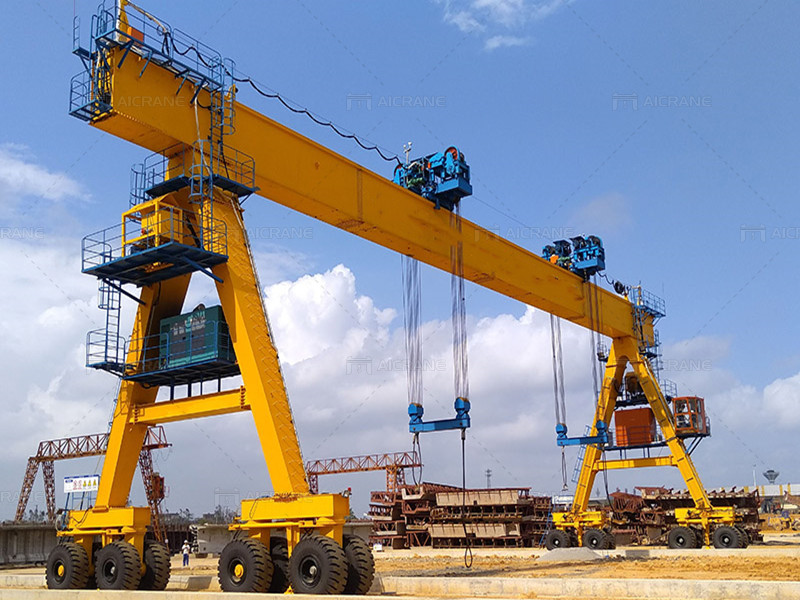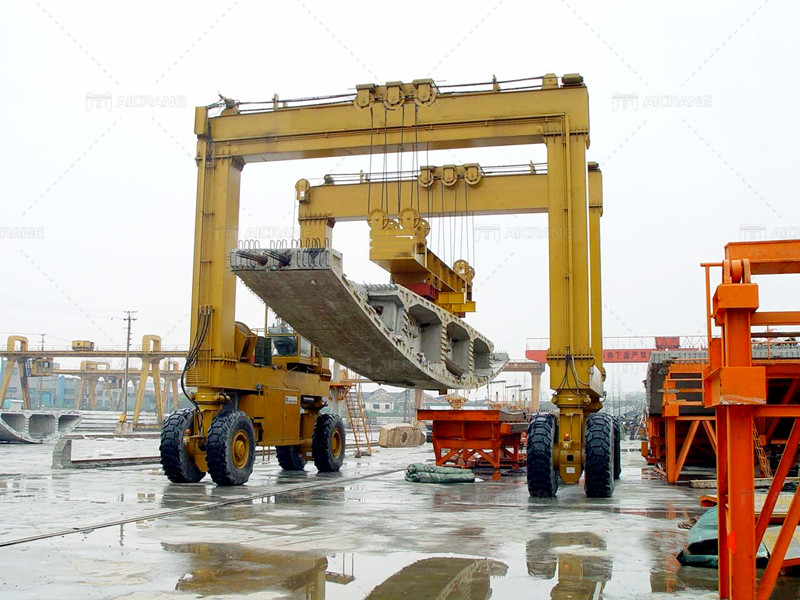Using a rubber tyred gantry crane efficiently and safely involves a series of well-coordinated steps and adherence to operational guidelines. Rubber tyred gantrys are versatile and commonly used in container terminals, intermodal yards, and ports for lifting and transporting containers. Understanding the proper procedures for using an RTG is crucial to ensure the smooth flow of cargo, minimize downtime, and maintain a safe working environment. Here is a comprehensive guide on how to use a rubber tyred gantry crane:

Pre-Operational Checks
Before initiating any operations, conduct thorough pre-operational checks to ensure that the rubber tyred gantry is in optimal condition. Inspect key components such as the tires, hoist, trolley, spreader, and control systems. Verify that all safety features, including limit switches and emergency stops, are functional. Any anomalies or issues identified during the pre-operational check should be addressed promptly.
Operator Training
Only trained and certified operators should be authorized to use a rubber tyred gantry crane. Operator training is essential to familiarize individuals with the controls, safety features, and operational procedures. Training programs typically cover aspects such as rubber tyred gantry controls, load handling, emergency procedures, and the use of safety equipment. Ongoing training and refresher courses should be provided to keep operators up-to-date with any advancements in equipment or operational protocols.
Safety Briefing
Before each shift or operational cycle, conduct a safety briefing with the rubber tyred gantry crane operators and ground personnel. Emphasize key safety protocols, potential hazards, and emergency procedures. Communication is vital during rubber tyred gantry crane operations, and ensuring that all personnel are aware of their roles and responsibilities contributes to a safer working environment.
Powering On the RTG
Start by powering on the rubber tyred gantry crane in accordance with the manufacturer’s guidelines. This involves activating the main power switch and any auxiliary systems. Ensure that the rubber tyred gantry crane is connected to a reliable power source, and verify that the battery (if applicable) is adequately charged. For diesel-powered rubber tyred gantry cranes, initiate the engine start-up procedure following the manufacturer’s instructions.
Control System Initialization
The rubber tyred gantry crane’s control system must be initialized before operation. This includes calibrating sensors, verifying communication between the control panel and the rubber tyred gantry crane components, and ensuring that the system is responsive to operator inputs. Any error messages or malfunctions displayed on the control panel should be addressed before proceeding.
Container Spreader Attachment
If the rubber tyred gantry crane is not equipped with a fixed spreader, attach the container gantry crane spreader to the hoist. Ensure that the spreader is securely connected and properly aligned with the container’s corner castings. For safety reasons, the spreader should be inspected regularly for any signs of wear or damage.

Container Pickup
Position the rubber tyred gantry crane over the target container using the joystick controls. Lower the spreader until it securely engages with the container’s corner castings. Lift the container smoothly and avoid sudden movements to prevent swinging. Once the container is lifted, the rubber tyred gantry crane can start horizontal movement to transport the container to its destination.
Horizontal Movement
Use the joystick controls to navigate the rubber tyred gantry crane horizontally. Rubber tyred gantry cranes are equipped with rubber tires that provide excellent mobility, allowing them to move between container stacks with precision. Operators should be attentive to their surroundings, ensuring that the RTG maintains a safe distance from other equipment, structures, or personnel.
Container Stacking
When placing a container into a stack, approach the designated stack location at a controlled speed. Lower the container gently to avoid impact or damage. Rubber tyred gantry cranes are known for their stacking capabilities, and operators should ensure that containers are aligned and stacked securely to optimize storage space.
Safety Interlocks
Rubber tyred gantry cranes are equipped with safety interlocks to prevent unsafe conditions or operations. These may include height restriction sensors, weight limit interlocks, and collision avoidance systems. Operators must be aware of these interlocks and respond to any warnings or alerts promptly. Disabling safety features is strictly prohibited.
Communication with Ground Personnel
Effective communication between rubber tyred gantry crane operators and ground personnel is crucial for safe and efficient operations. Ground personnel, including spotters and supervisors, play a key role in guiding rubber tyred gantry crane movements, especially in busy terminal environments. Clear and standardized communication protocols should be established and followed.
Parking and Shutdown
When the rubber tyred gantry crane is not in use or at the end of a shift, park the crane in a designated area. Follow the guidelines of crane manufacturers for proper shutdown procedures, including securing the container spreader, disengaging the hoist, and turning off the main power. If applicable, retract the legs or outriggers to ensure stability during non-operational periods.
Routine Maintenance
Regular maintenance is essential for the continued reliability and performance of the rubber tyred gantry crane. Establish a routine maintenance schedule that includes tasks such as lubricating moving parts, inspecting tires for wear, and checking electrical components. Routine maintenance helps prevent equipment failures and ensures a longer lifespan for the rubber tyred gantry crane.
Emergency Procedures
Rubber tyred gantry crane operators should be well-versed in emergency procedures to respond effectively to unexpected situations. This includes procedures for power failures, equipment malfunctions, or accidents. Emergency stops and cutoffs should be easily accessible and functional.
Ongoing Training and Continuous Improvement
To enhance operational efficiency and safety, implement ongoing training programs for rubber tyred gantry crane operators. Encourage continuous improvement by incorporating feedback from operators, conducting regular safety audits, and staying updated on industry best practices and technological advancements.
In conclusion, using a rubber tyred gantry crane involves a combination of operational skills, safety awareness, and adherence to established protocols. By following these guidelines, operators can ensure the efficient and safe handling of containers, contributing to the overall productivity and success of container terminals and similar facilities.